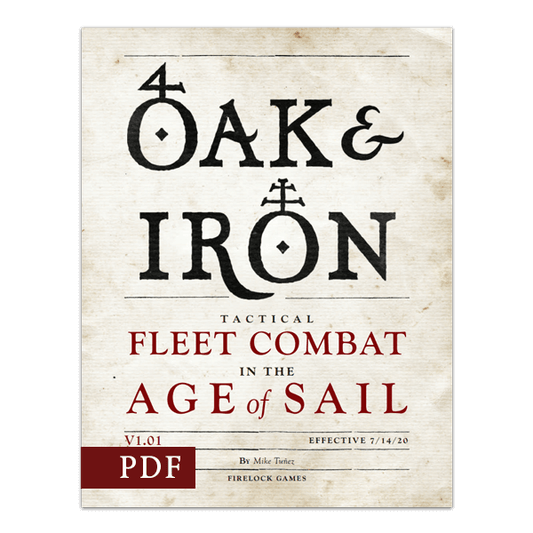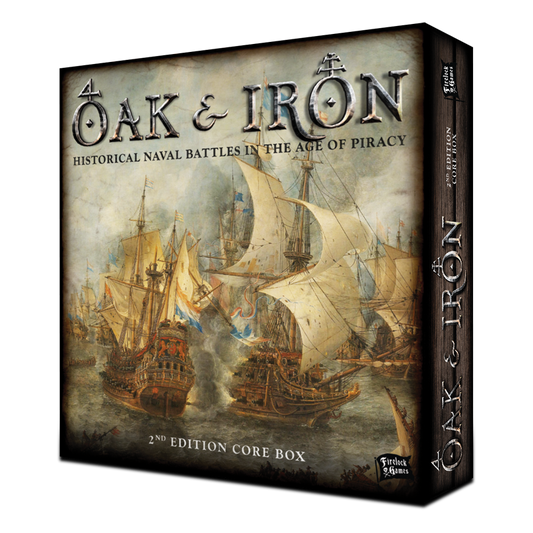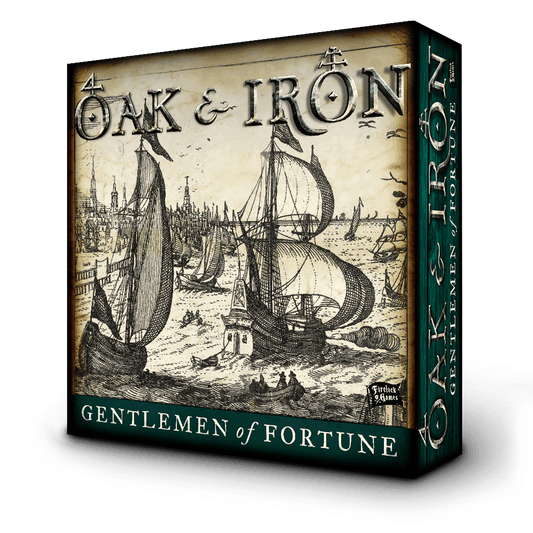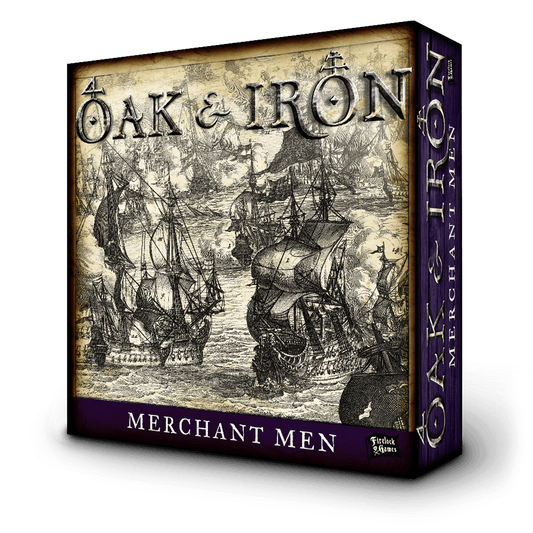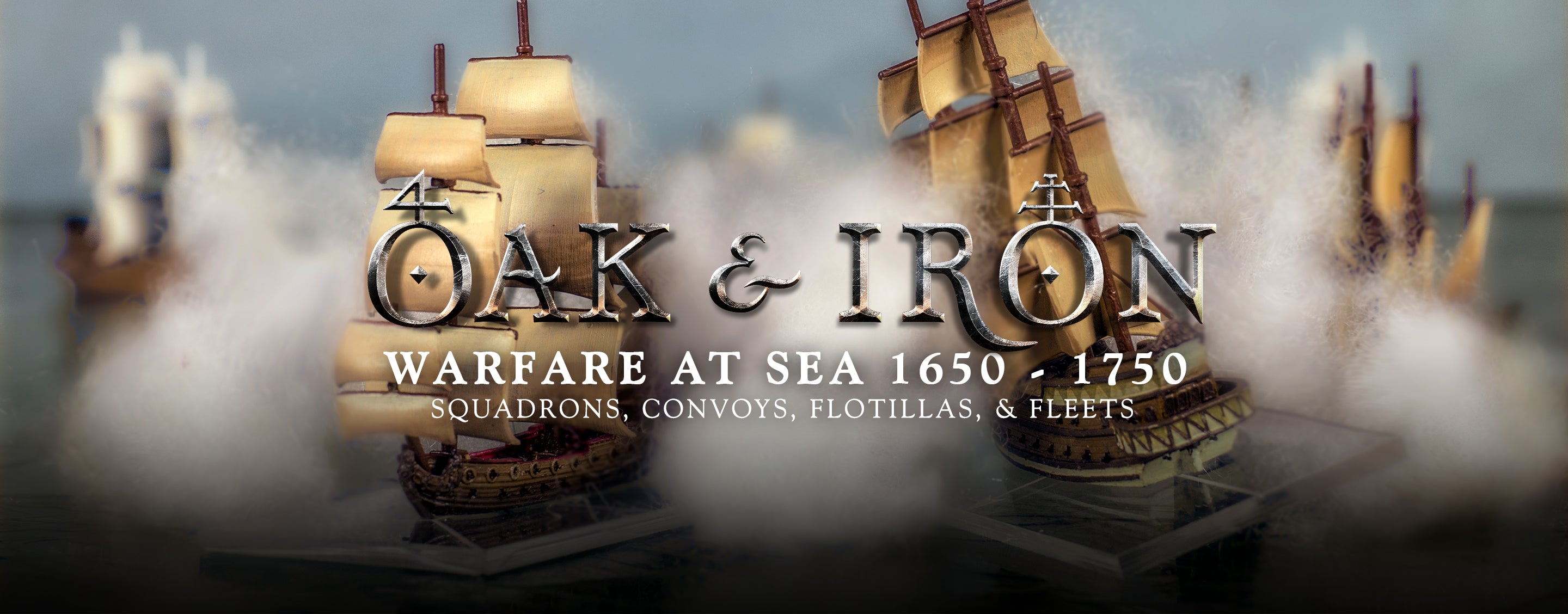
Oak & Iron
Who ever saw a noble sight,
That never view’d a brave sea-fight!
Hang up your bloody colours in the air
Up with you fights, and your nettings prepare;
Your merry mates cheer, with a lusty bold spright…
—John Dryden, “Song of the Sea-Fight, in Amboyna,” ca. 1685
Oak & Iron is a 1/600th scale naval game set in the age of piracy, imperial expansion, and above all, fighting sail. It allows players to recreate battles between small fleets and squadrons of armed sailing ships. The game is designed to be simple and intuitive while also challenging players by providing significant tactical depth, being true to the theme and tactics of the period, and supplying significant flavor for the various factions represented in the game.
Oak & Iron Downloads
Guides & Cutouts
Introduction Video
Oak & Iron Products
-
Oak & Iron Rulebook 2nd Edition (PDF)
Regular price $0.00 USDRegular priceUnit price / per -
Oak & Iron 2nd Edition Corebox
Regular price $69.00 USDRegular priceUnit price / per -
Oak & Iron Gentlemen of Fortune Expansion
Regular price $29.00 USDRegular priceUnit price / per -
Oak & Iron Merchant Men Expansion
Regular price $29.00 USDRegular priceUnit price / per
GAME DESIGNER’S NOTES
-
1. COMMAND AND CONTROL
This was a critical factor in naval battles and is often overlooked or overcomplicated in other systems. Oak & Iron uses a hand of initiative cards to determine initiative and also command and control. Each player constructs a hand of 5-8 initiative cards. These cards represent the battle plans and signals given to the captains of each fleet by the admiral beforehand. These cards will both determine which fleet has the initiative for the turn and will usually give a bonus to the fleet that lasts for the remainder of the turn. These cards are chosen at the beginning of the previous turn, so commanders have to think a turn ahead to get the most out of their chosen card.
-
2. FACTION FLAVOR
Many naval games reflect national differences simply by skill and ship ratings. Those things are present in Oak & Iron, but we add another layer on that. Each of the game’s factions have a distinct period flavor. Many upgrade and initiative cards are specific to certain factions and reflect their national doctrine, tactics, and skills. This makes all of the fleets feel unique without adding an overabundance of stats that need to be remembered, adding unneeded complexity to the game.
-
3. QUICK AND SIMPLE
While many age of sail games place the focus on the intricacies of sailing ships, Oak & Iron is a game played from the Admiral’s perspective. The Admiral is not as focused on the exact point of sail of each of the ships in the fleet, but rather whether or not they are where they are supposed to be in relation with the rest of the fleet. The game is designed to streamline the rules for sailing to keep the game fast, furious, and focused on tactics rather than the minutia. The important aspects of sailing are present (no sailing in the wind’s eye!), but abstracted to keep it intuitive, and focused on fleet positioning and maneuvering.
-
4. ACCESSIBILITY
The game will be based around a boxed starter set with everything two players need to get started and plastic ship models with brown hulls and white sails so that even without painting, they won’t look out of place. Outside of that, players will be able to buy expansion boxes of ships (including cards and tokens) to add more ships to their fleets.
-
5. HISTORIC PERIOD
This one is especially important I think. The game’s time frame covers the beginning of line of battle tactics in the mid 17th century all the way to the middle of the 18th century. This is a period where most of the major powers at sea where on relatively level footing and is a stretch of time that very few rulesets currently cover. Of course, the golden age of piracy (roughly 1660-1720) also falls into this period and as we all know, people love pirates! So the option to have some real historical pirates in the game is sure way to draw in people of all ages who would otherwise not be interested in a historical game.

